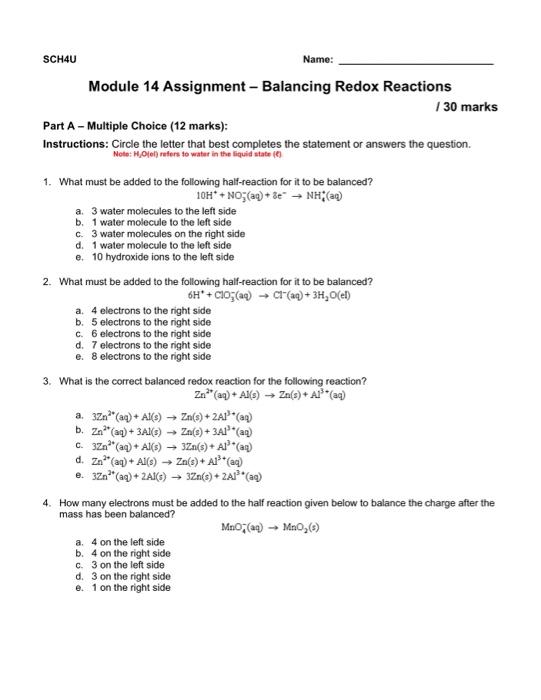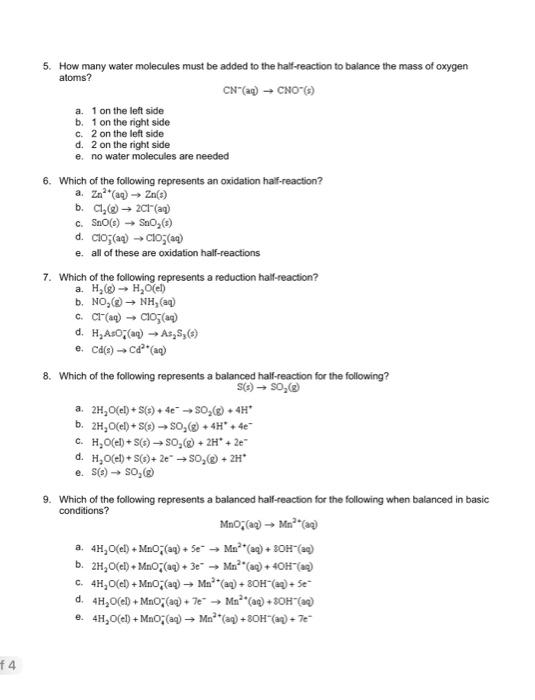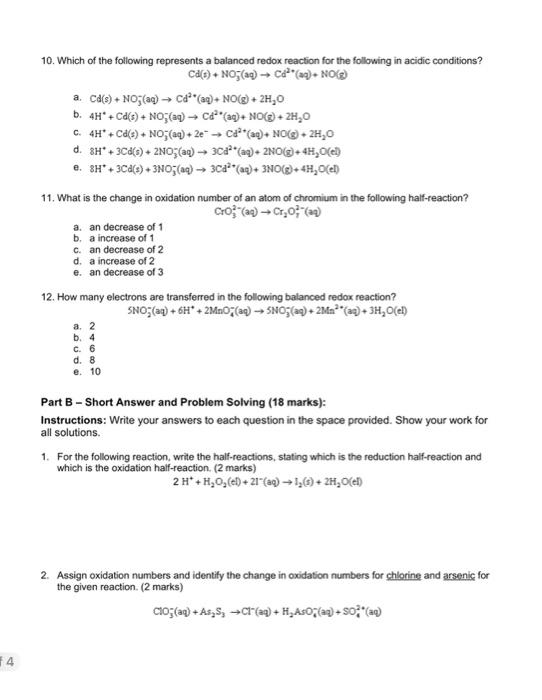please answer all questions and i will leave a like. thanks!

Part A - Multiple Choice (12 marks): Instructions: Circle the letter that best completes the statement or answers the question. Nete: M,OYel) refers to water in the liquid state (f) 1. What must be added to the following half-reaction for it to be balanced? 10H++NO3(aq)+eNH4(aq) a. 3 water molecules to the left side b. 1 water molecule to the left side c. 3 water molecules on the right side d. 1 water molecule to the left side e. 10 hydroxide ions to the left side 2. What must be added to the following half-reaction for it to be balanced? 6H++ClO3(aq)Cl(aq)+3H2O(el) a. 4 electrons to the right side b. 5 electrons to the right side c. 6 electrons to the right side d. 7 electrons to the right side e. 8 electrons to the right side 3. What is the correct balanced redox reaction for the following reaction? Zn2(aq)+Al(s)Zn(s)+Al3+(aq) a. 3Zn2(aq)+Al(s)Zn(s)+2Al3(aq) b. Zn2+(aq)+3Al(s)Zn(s)+3Al3+(aq) c. 3Zn2+(aq)+Al(s)3Zn(s)+Al3+(aq) d. Zn2+(aq)+Al(s)Zn(s)+Al3+(aq) e. 3Zn2+(aq)+2Al(s)3Zn(s)+2Al3(aq) 4. How many electrons must be added to the half reaction given below to balance the charge after the mass has been balanced? MnO4(aq)MnO2(s) a. 4 on the left side b. 4 on the right side c. 3 on the left side d. 3 on the right side e. 1 on the right side 5. How many water molecules must be added to the halfreaction to balance the mass of oxygen atoms? CN(aq)CNO(s) a. 1 on the left side b. 1 on the right side c. 2 on the left side d. 2 on the right side e. no water molecules are needed 6. Which of the following represents an oxidation haff-reaction? a. Zn2+(aq)Zn(s) b. Cl2(g)2Cl(aq) c. SnO(s)SnO2(s) d. ClO3(aq)ClO2(aq) e. all of these are oxidation half-reactions 7. Which of the following represents a reduction half-reaction? a. H2(8)H2O(el) b. NO2(g)NH2(aq) c. Cl(aq)ClO3(aq) d. H2AsO4(aq)As2S3(s) e. Cd(s)Cd2+(aq) 8. Which of the following represents a balanced half-reaction for the following? S(s)SO2(s) a. 2H2O(el)+S(s)+4eSO2(g)+4H b. 2H2O(el)+S(s)SO2(g)+4H+4e c. H2O(el)+S(s)SO2(g)+2H+2e d. H2O(el)+S(s)+2eSO2(g)+2H e. S(s)SO2(g) 9. Which of the following represents a balanced half-reaction for the following when balanced in basic conditions? MnO4(aq)Mn2(aq) a. 4H2O(el)+MnO4(aq)+5eMn2+(aq)+8OH(aq) b. 2H2O(el)+MnO4(aq)+3eMn2(aq)+4OH(aq) c. 4H2O(el)+MnO4(aq)Mn2(aq)+8OH(aq)+5e d. 4H2O(el)+MnO4(aq)+7eMn2(aq)+3HH(aq) e. 4H2O(el)+MnO4(aq)Mn2+(aq)+8OH(aq)+7e 10. Which of the following represents a balanced redox reaction for the following in acidic conditions? Cd(s)+NO3(aq)Cd2(aq)+NO(g) a. Cd(s)+NO3(aq)Cd2(aq)+NO(g)+2H2O b. 4H+Cd(s)+NO3(aq)Cd2(aq)+NO(s)+2H2O c. 4H+Cd(s)+NO3(aq)+2eCd2(aq)+NO(s)+2H2O d. 8H+3Cd(s)+2NO3(aq)3Cd2+(aq)+2NO(s)+4H2O(el) e. 8H+3Cd(s)+3NO3(aq)3Cd2(aq)+3NO(g)+4H2O(el) 11. What is the change in oxidation number of an atom of chromium in the following half-reaction? CrO32(aq)Cr2O72(aq) a. an decrease of 1 b. a increase of 1 c. an decrease of 2 d. a increase of 2 e. an decrease of 3 12. How many electrons are transferred in the following balanced redox reaction? 5NO2(aq)+6H+2MnO4(aq)5NO3(aq)+2Ma2(aq)+3H2O(el) a. 2 b. 4 c. 6 d. 8 e. 10 Part B - Short Answer and Problem Solving (18 marks): Instructions: Write your answers to each question in the space provided. Show your work for all solutions. 1. For the following reaction, write the half-reactions, stating which is the reduction half-reaction and which is the oxidation half-reaction. (2 marks) 2H++H2O2(el)+2I(aq)I2(s)+2H2O(el) 2. Assign oxidation numbers and identify the change in oxidation numbers for chlorine and arsenic for the given reaction. ( 2 marks) ClO3(aq)+As2S3Cl(aq)+H2AsO4(aq)+SO42(aq) 3. Balance this redox reaction in acidic conditions using the half-reaction method. (3 marks) Cd(s)+NO3(aq)Cd2(aq)+NO(g) 4. Balance this redox reaction in basic conditions using the half-reaction method. (3 marks) H2O2(aq)+1(aq)I2(s)+H2O(el) 5. Use the oxidation number method to balance the following redox reaction in acidic conditions. (4 marks) Sn2+(aq)+Cr2O2(aq)Sn4+(aq)+Cr3(aq) 6. Use the oxidation number method to balance the following redox reaction in basic conditions. (4 marks MnO4(aq)+Cl(aq)Mn2(aq)+Cl2(g)











